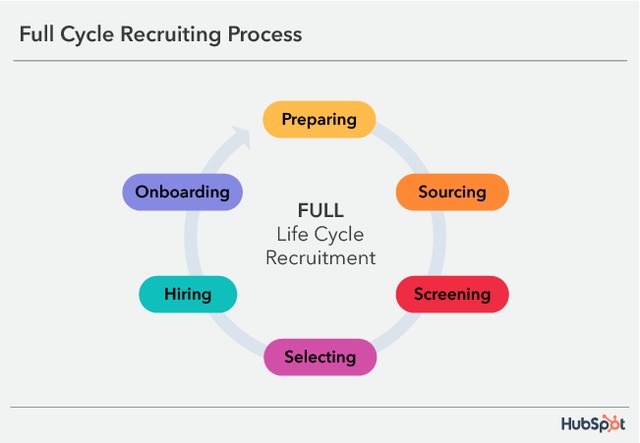Job vacancies can cost a company an average of $500 per day.
Companies can save money, improve the quality of their hires, eliminate communication gaps, and increase accountability during the recruitment process by implementing a full-cycle recruitment strategy.
The full-cycle recruitment process is managed by a single full-cycle recruiter or full-cycle recruiting agency.
Full-Cycle Recruiting Process

The full-cycle recruiting process includes six stages: preparing, sourcing, screening, selecting, hiring, and onboarding.
Preparing
The first stage of the full-cycle recruiting process is the preparing stage. A recruiter will begin this stage by working with a hiring manager to identify a hiring need and create a persona — a fictionalized profile of your company's ideal candidate.
During the next step of the preparing stage, the recruiter and hiring manager will determine how much compensation a candidate will be offered. This information will be used to create a job posting that includes an overview of the role, responsibilities, salary range, benefits, and information about the company.
Sourcing
After creating a persona and job posting, a recruiter will use word-of-mouth, internal recruiting, employee referrals, social media, job boards, or career websites such as LinkedIn and Glassdoor to find jobseekers that fit the ideal candidate persona.
Screening
After finding potential candidates, a recruiter will carefully review applicants' resumes and cover letters with the help of HR software. Then, the recruiter will perform a phone screen or on-demand interview.
For most talent acquisition leaders, resume screening is the most time-consuming and challenging part of recruitment.
Selecting
After screening and shortlisting candidates, the recruiter will determine which candidate is the best fit for the role by conducting face-to-face or virtual interviews.
A recruiter will ask candidates in-depth questions to learn more about their professional background and qualifications during a face-to-face interview. The recruiter may also have candidates complete writing assignments or a series of tasks to prove they are a good choice for the position.
Once the recruiter selects the best candidate, they will check the candidate's references or order a background check.
Hiring
The hiring stage is the most important of the process.
After choosing the best candidate for the role, the recruiter will contact the candidate with an official job offer and may have to negotiate the terms of the offer. The candidate may feel more comfortable receiving a job offer from the full-cycle recruiter rather than the hiring manager because the recruiter has been the candidate's primary contact throughout the hiring process.
Onboarding
The final stage of the full-cycle recruiting process is the onboarding stage. During the onboarding stage of the process, a hire is integrated into the company. The full-cycle recruiter will familiarize the new hire with the company culture and team members using a welcoming orientation or introductory path.
1. Identify the ideal candidate for the role.
A candidate persona is a description of your ideal applicant. Creating a candidate persona will help your recruiter choose the best applicant for the role by honing in on the criteria that your ideal candidate should meet.
To create a persona, start by asking yourself questions about your ideal candidate to identify their skills, qualifications, experience, education, and background. For example, what industry do they currently work in? Do they hold the role that you are hiring for? What are their professional goals? What work environment do they thrive in?
Once you have answered the questions, interview managers at your business who would oversee your ideal candidate and ask about the skills that would help employees thrive in the role. Use the managers’ recommendations to help craft your ideal candidate’s persona.
2. Find potential candidates.
Create advertisements that target jobseekers who fit your ideal candidate persona. Post the advertisements to social media websites and job boards such as LinkedIn, Facebook, and Glassdoor to reach potential candidates searching for new positions.
You can also use promotions and transfers to recruit existing employees who may qualify for the position. Internal recruiting can help your company reduce onboarding time, boost morale, and save time and money.
3. Review candidates’ resumes and cover letters.
Use applicant tracking software (ATS) to scan applicants’ resumes and cover letters for criteria that matches your ideal candidate persona, such as education, years of experience, and previous job titles.
If you are reviewing resumes and cover letters manually, scan each resume for keywords that match the open position. Next, separate them into 3 categories: resumes that do not meet the criteria for the position, resumes that meet some of the criteria, and resumes that meet all of the criteria. Double-check the resumes in each category.
Place the candidates that are closest to your company's ideal candidate persona on a shortlist.
4. Conduct face-to-face or virtual interviews with shortlisted candidates.
Interviewing shortlisted candidates can help you find the best fit for the job. By interviewing candidates, you can learn more about their experiences and qualifications, their potential to fit into your company culture, and their soft skills, such as how they perform under pressure.
Conducting standardized interviews can also help you view candidates objectively and prevent bias in the hiring process.
5. Contact the best candidate with an official job offer.
After conducting interviews, extend an official job offer to the best candidate. Indeed recommends contacting the candidate by phone the same day as their final interview or within one day of making your decision.
Benefits of Full-Cycle Recruiting
Full-cycle recruiting improves the efficiency of the hiring process in five key ways:
Faster Hiring
The full-cycle recruiting process reduces time-to-hire, making the recruitment process more efficient. Time-to-hire is a measure of the time between when a candidate enters the pipeline and when they are officially hired. A shortened time-to-hire reduces the risk of a company losing out on highly qualified candidates that may be simultaneously interviewing at other companies.
Streamlined Strategy
Using a full-cycle recruiting strategy streamlines the recruitment process. It eliminates delays caused by communication gaps because the process is handled by a single recruiter or agency that can construct a simple strategy and follow it through to the end.
Improved Quality of Hire
Quality of hire measures the value a new hire contributes to a company’s overall success. Improving the quality of hire increases employee engagement, improves job satisfaction and productivity levels, and decreases turnover costs.
A full-cycle recruiter implements a more personalized and thorough process than a traditional recruiter. As a result, full-cycle recruiting improves the quality of hire by precisely identifying the best candidate for a position.
Increased Accountability
Because one person manages the entire full-cycle recruiting process, all of the successes and failures of the process are their responsibility. The recruiter benefits from this responsibility because they can't lose a candidate due to someone else's mistakes.
Improved Communication
In full-cycle recruiting, candidates remain in communication with a single person throughout the hiring process. Therefore, the process alleviates any possible concerns a candidate may have about delays caused by miscommunication between hiring personnel.
Full-Cycle Recruiting Process Results
A well-executed full-cycle recruiting process will result in an employee who feels prepared on their first day. This is all thanks to a full-cycle recruiter who guided them through the recruitment process, maintained communication, and provided necessary information about the job position and the company.

